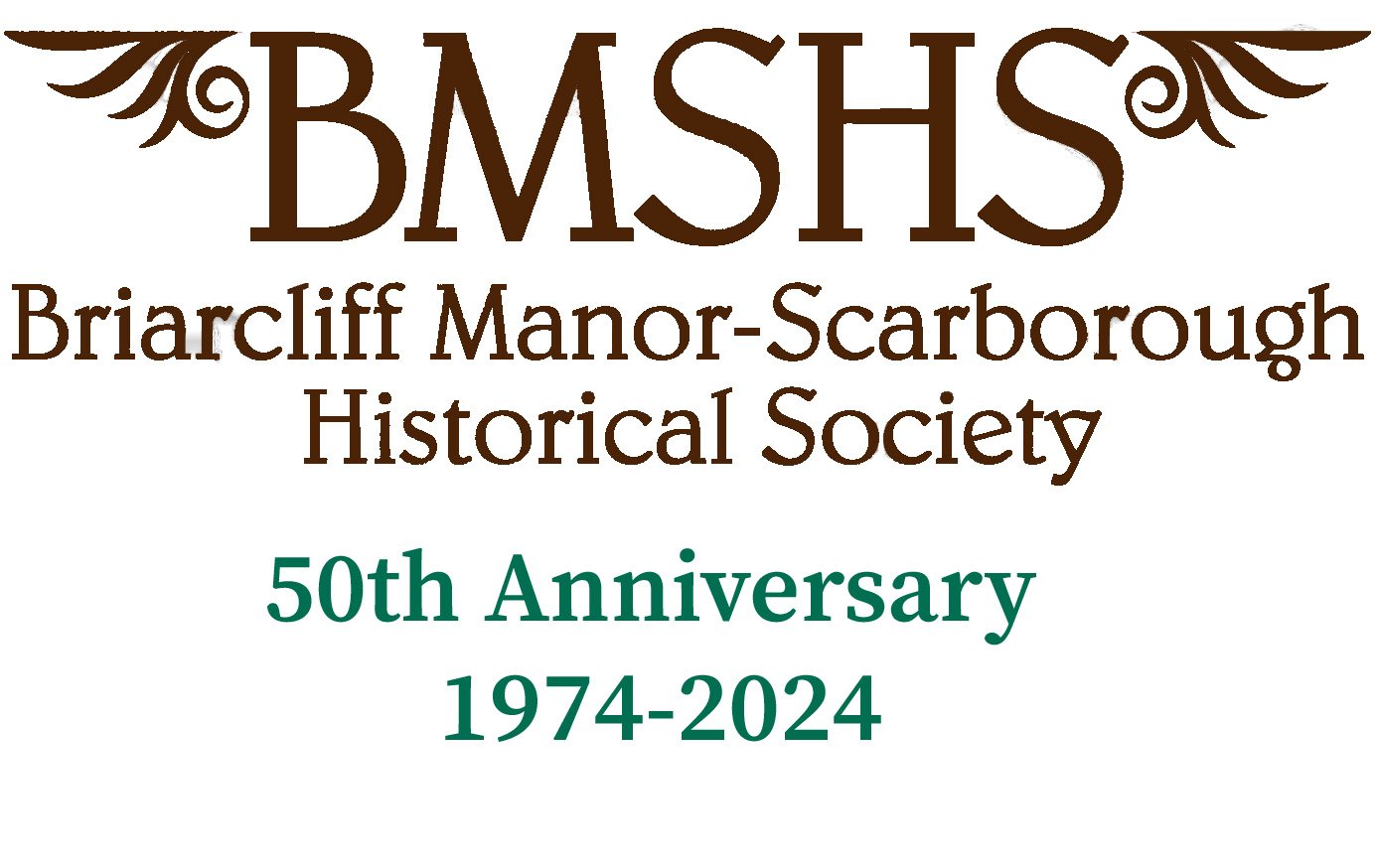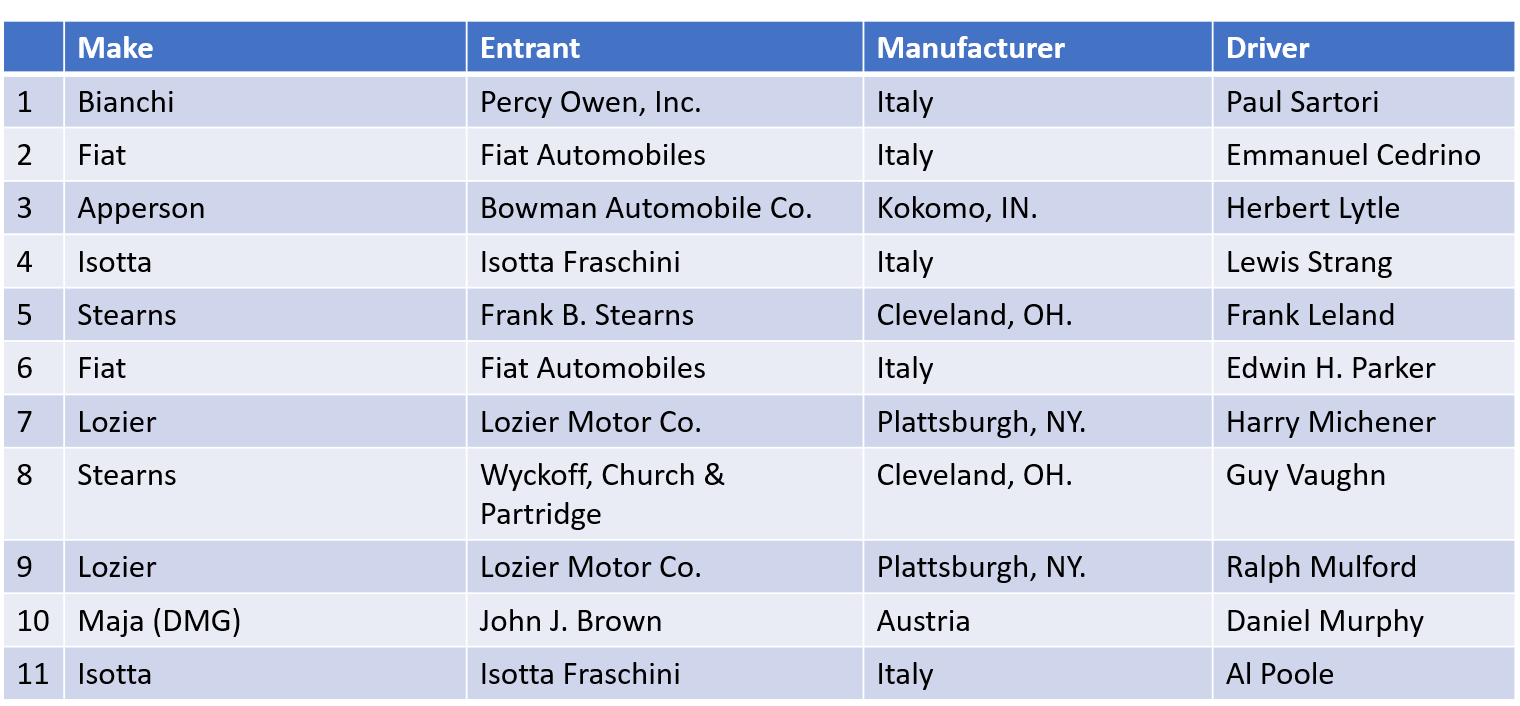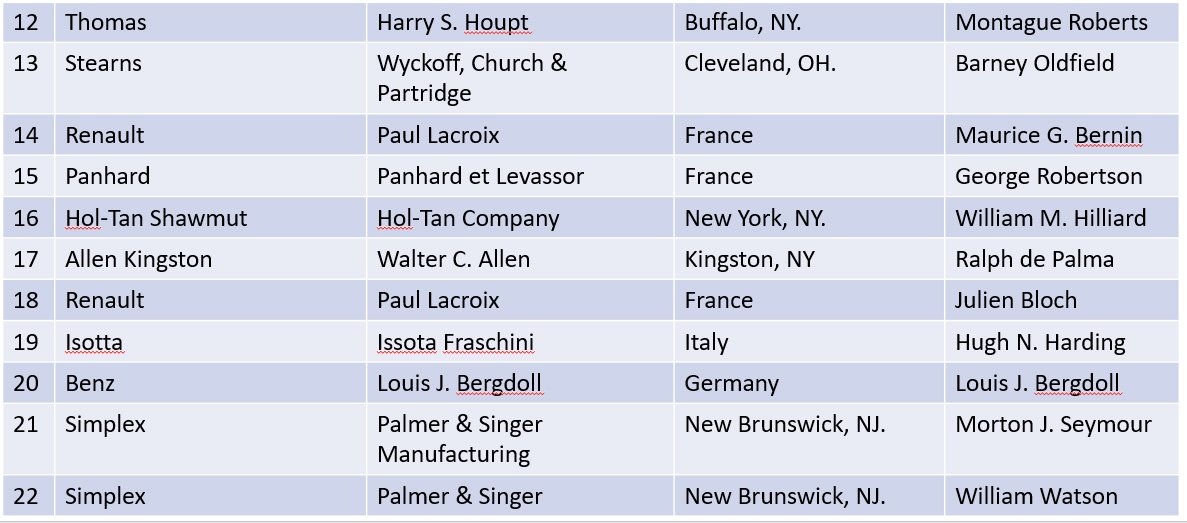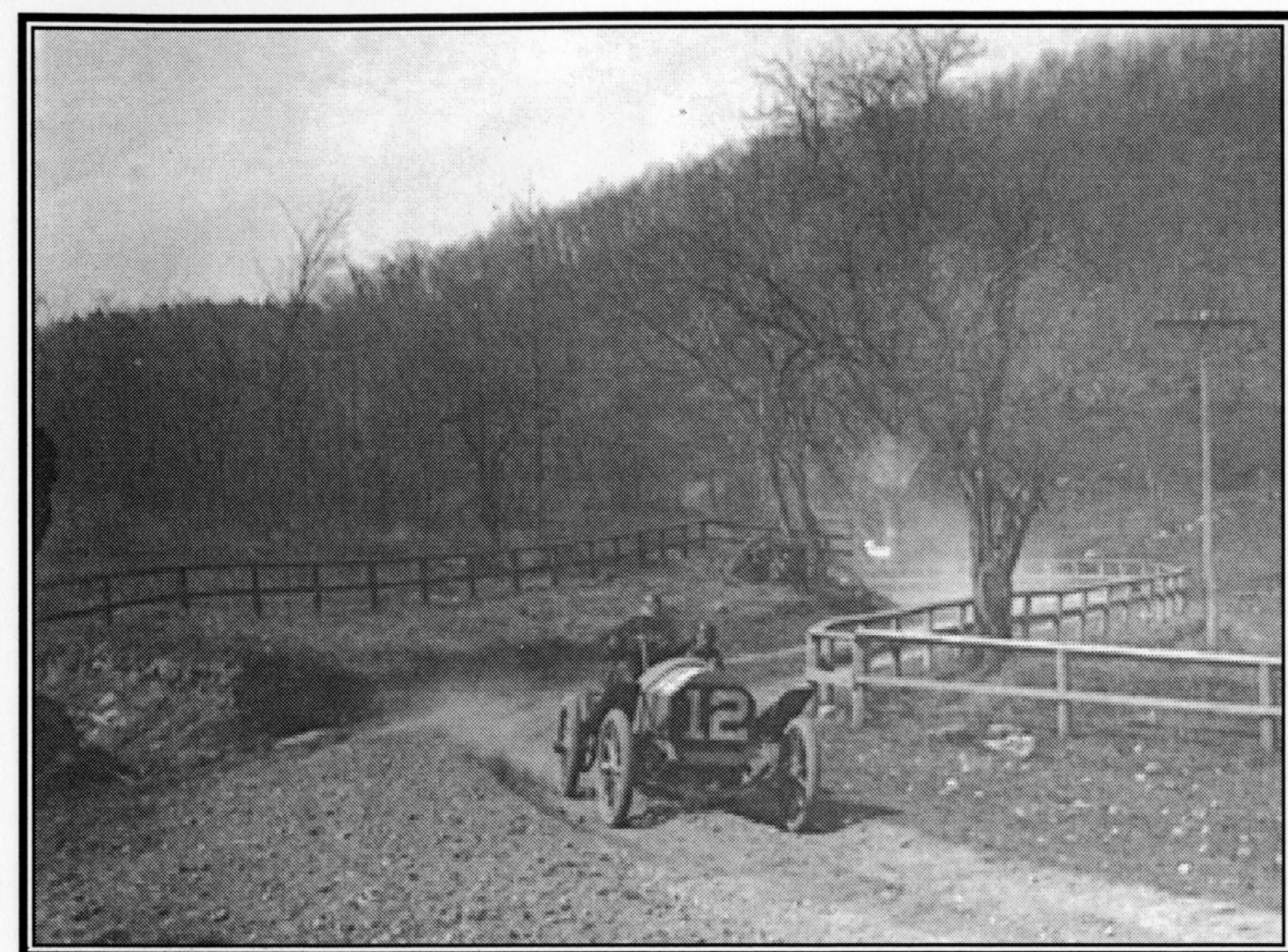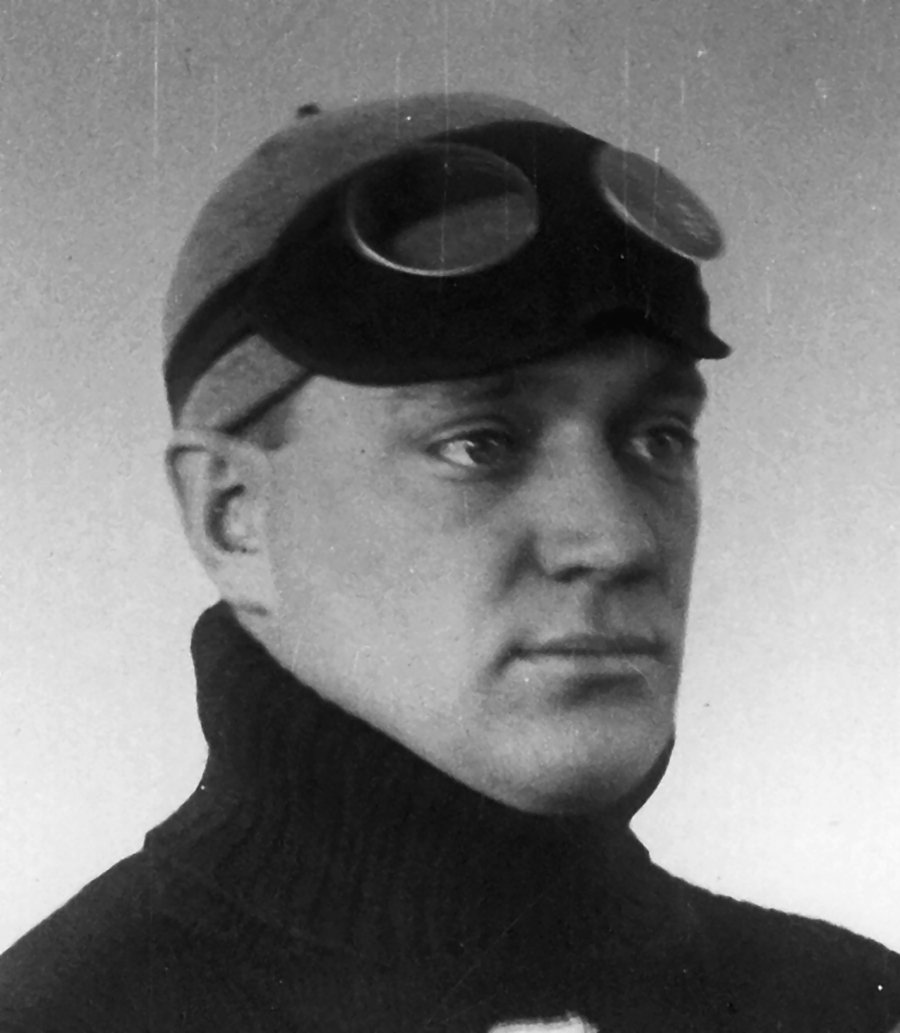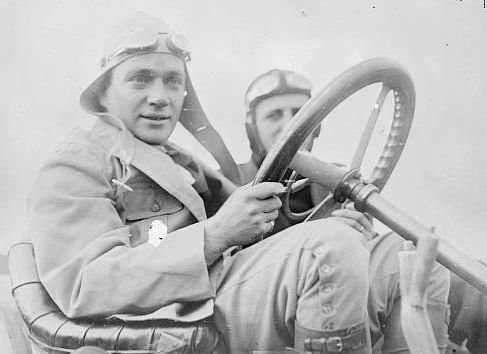The 1908 Briarcliff Trophy Race. Notebook 2024-3
On Friday, April 24, 1908 an event took place in Briarcliff Manor the like of which had never been seen in the village before and has not been seen since.
The 1908 Briarcliff Trophy Race
SOME FACTS
The Trophy
The course spanned much of Westchester County. The 32.4-mile circuit was to be completed 8 times for a total of 259.2 miles. The original plan was for 10 laps for a total of 324 miles, but this was changed because of limits to how long the roads could be kept open and that entrants would drive dangerously in order to meet the deadline. There were 22 entrants with vehicles from five countries: Austria, France Germany, Italy and the US. All cars were four-cylinder stock cars. 19 of them had four speeds while the Isolas had three speeds. All 22 entrants were men. June Cuneo the most prominent female racing driver was denied entry. 300,000 people watched the race throughout the county, and Briarcliff Manor had more than 100,000 visitors on that day.
Why hold a car race at this time? The Automobile was only about ten years old and Manufacturers wanted to showcase traffic after 1907 depression. They also wanted to show that cars were not just toys for the wealthy, that the vehicles were thoroughly tested vehicles that could safely, comfortably and reliably carry passengers on a variety of surfaces (paved roads were rare at that time).
But why have the race in Briarcliff Manor? Walter Law had founded Briarcliff Manor in 1902 He wanted to showcase the village as a great place to live and to generate some publicity for his businesses. He was interested in automobiles and was President of the Upper Westchester Auto Club. Importantly he had the money and the connections to make it happen
Mr. Law offered the winner a prize of $10,000 dollars (Over $300,000 today) for the winner along with a several foot high custom-built trophy. Law presented the trophy himself, which now resides at the Indianapolis Speedway Museum
The race would not be driven on a specially built racetrack. Rather it would be on the “Open Road” i.e. it would run on whatever surfaces the local roads provided. It would run over a 30 plus mile route through eight towns and villages on whatever surfaces local roads provided. Over a 30 plus mile route THE AUTOMOBILE called the Briarcliff course a “tortuous circuit of the crumpled-up paper type, with impossible bends and turns, each one with its pitfall of narrow, creaky bridge, or its menacing stone wall, and with scarcely a quarter mile straight, or a half dozen places where a competitor could safely be passed at speed,” nerve was as necessary as talent for the twenty-two participating drivers. From Gregg D. Merksamer: “Remembering the 1908 Briarcliff Trophy Race”.
THE PARTICIPANTS
It wasn’t all smooth sailing. It took over a year to bring to fruition after much negotiation including many plans and counter plans. A local Justice threatened to shut it down if drivers didn’t obey speed limits. A state engineer demanded that $200 (about $6,500) security be escrowed for each course mile. And perhaps worst, shameless promoters charged $25 (about $800 today) for parking in fields when the average hourly wage rate was 22 cents (about $7 today).
THE ROUTE
The Route
TALES FROM THE RACE
Briarcliff Start
A County Sheriff assembled an amateur militia, which fought with unruly spectators and the race started at 5:07 am, 22 minutes late. The cars started at one minute intervals. Because of the delay and thousands of spectators lining the route, the race was reduced from ten to eight laps
Briarcliff Start
Kitchawan Railroad Crossing
The drivers encountered early morning fog and Barney Oldfield narrowly missed hitting a train here. The train managed to stop, but its cow-catcher spread over the road. Oldfield gunned his engine and blasted over the cow-catcher at full speed.
Pinesbridge
Near the New Croton Reservoir created by the building of the New Croton Dam in the previous year, this was one of the prettiest parts of the route. Amazingly, even with several sharp turns and tight corners, nobody drove into the Reservoir.
Mount Kisco
Local government required that on entering Mount Kisco the racers be escorted by motorcycles along a 2.8-mile control zone with a speed limit of 20mph.
Newcastle Corners
The Maximum speed of 75mph was achieved over this four-mile plus stretch.
The Armonk Curve
While practicing two days before the race Al Campbell in his Allen-Kingston missed the curve, somersaulted the car into the creek and broke his jaw.
Route 22-Kensico
Another near straightaway
Kensico Dam
The drivers passed over the top of the dam.
Eastview
This was the site of the only serious crash. On the first lap R.C. Watson’s Simplex hit a phone pole and flipped over, badly bending his steering post. Fortunately, it damaged only machines and not people. Three hours later, after repairs, he drove off again and managed to complete five laps before time ran out.
The Northern Route
On country roads on what is now the Saw Mill River Parkway and Route 9A
Briarcliff Finish
At 11:40am the winner got the checkered flag after covering the 256-mile course in five hours, 14 minutes and 13.5 seconds, with an average speed of 45.22 mph. He received the $10,000 first place purse, and the silver trophy that can now be seen at the Indianapolis Speedway Museum. He also received a $1,000 bonus from his employer, John H.Tyson and cash prizes from companies making various components he used.18 of the 22 entrants finished.
RACE PICTURES
The finish line is roughly 100 feet south of the present traffic light at Pleasantville and North State roads.
The big barn below the Briarcliff Lodge served as the garage for 1908 race entrants like R.C. Watson’s #22 Simplex. It was only demolished in the early 2000s.
The Start-Finish line in Briarcliff Manor; looking towards the northeast. From here the racers headed out of the village on what is now known as North State Road, after which they took the Old Somerstown Turnpike to Merritt’s Corners (basically NY 100 and the town of Millwood today) and the Croton Reservoir beyond.
The Briarcliff Lodge looms in the background as William Hillard’s #16 Shawmut starts another lap. Though the Hol-Tan Co. had sent the car from Boston only three days before the start, Hilliard managed an 11th place finish out of 22 starters
Montague Roberts was leading the epic New York-to-Paris Race when he was recalled from Cheyenne, Wyoming to drive the #12 Thomas in the 1908 Briarcliff Trophy. His 13th place finish wasn’t one of his best.
Though George Robertson would finish the April 24th, 1908 Briarcliff Trophy toward the back of the field in his French-built #15 Panhard, he would attain immortality the following October 24th after taking the “Old 16” Locomobile to an American car-maker’s first victory in the Vanderbilt Cup on Long Island.
Judging from the relatively thick crowds and the Victorian house on the hill, this shot of M.J. Seymour’s #21 Simplex on the 1908 Briarcliff Trophy may have been taken just northeast of the start-finish line on what is now North State Road. If so, the current corridor for 9A replaced the bridge in the center of this image.
“Coal scuttle” hoods distinguished the two shaft-driven, 50-hp Renaults used by Maurice Bernin and Julian Bloch in the 1908 Briarcliff Trophy race. This photo was most likely taken at the bottom of the big hill at Eastview, which now intersects some of the busiest commuter high-ways in New York City’s northern suburbs.
R.C. Watson’s #22 Simplex travels on typically rough and twisting roads during the 1908 Briarcliff Trophy. Though it took three hours to repair the bent steering post after he hit a phone pole at Eastview and flipped over on the first lap, Watson was able to rejoin the race and complete five circuits by the finish.
Louis J. Bergdoll’s 50hp Benz goes for broke on one of the 1908 Briarcliff Trophy’s few straight sections. The Pennsylvania millionaire was the only entrant driving his own car instead of hiring a professional.
After tackling the twisty southern shore of the New Croton Reservoir, Barney Oldfields’3 #13 Stearns entered Mt. Kisco from the north and was escorted through 2.8-mile-long Control Zone with a 20mph limit making the Briarcliff’s official mileage 29.6 miles per lap. Hugh Harding’s #19 Isotta Fraschini follows close behind,
Barney Oldfield may now be the best-known 1908 Briarcliff racer, but his Stearns certainly lived up to its #13 entry number’s unlucky aura after a near collision with a train at Kitchawan and a clogged fuel line that left him stranded on the big hill beyond Valhalla. He nonetheless finished in 10th place out of 22 starters. Note here how his pit area was covered with planking to ensure a hard, smooth working surface
A blown right rear tire and three burned-out spark plugs costs Herb Lytle’s #3 Apperson his second-place position on the last half of the last lap. Back in Briarcliff, he nonetheless received a warm reception after finishing in fourth place with a time of five hours, 39 minutes and 15 and 2/3 seconds
Some of the race viewing areas looked more like old-time movie drive-ins, but nearly 300,000 spectators lined the 30-mile course, some of them here all night in anticipation
Briarcliff itself had about 100,000 visitors that day.
WHO WAS THE WINNER?
Guy Vaughn (Wyckoff, Church and Partridge in Stearns Car) came in third
Emmanuel Cedrino (Fiat Company, in Fiat Car) to second place
Lewis Strang
The winner was Lewis Strang (Isotta Fraschini, in Isotta Car). The prize, the Briarcliff Trophy valued at over $10,000 (over $300,000 today), was donated and presented by Briarcliff Manor founder Walter W. Law.
Lewis Strang, practiced for five weeks in a six-cylinder Ford owned by John H. Tyson. The Isotta he used in the competition (also owned by Tyson) was only driven over the course twice before the race, and was otherwise locked and guarded in the owner's garage. In the race, Strang took the lead on the first lap and never let go, thus winning the race and trophy. He had consistently made four of his laps in just over 38 minutes, with an elapsed time of 5 hours,14 minutes, 13 and 1/5 seconds and a 45.22 mph average over 236.8 miles of actual racing. John Tyson claimed to have spent $25,000 to win the trophy but gave Strang credit for the triumph. Strang received $1,000, along with a $5,000 bonus from Tyson. His mechanic received $500 along with a bonus.
Ralph Mulford tells of a racing maneuver employed by Lewis Strang in winning the race. Whenever threatened with being overtaken, Strang's riding mechanic poured kerosene on the exposed exhaust pipes. The resultant clouds of smoke engulfed the pursuing car. With visibility at zero, its driver refrained from any attempt to pass. Actually, the records indicate that Strang had never been overtaken or even seriously threatened.
Lewis Strang
Lewis Strang
Tragically Strand would not enjoy his success for long About 1 pm on Thursday, 20 July 1911 (i.e. about three years after the Briarcliff race), Strang crossed a bridge onto a newly built toll road near the town of Blue River, Wisconsin. A horse-drawn cart approached and Strang stopped his Case passenger car, to avoid frightening the horse. Strang's car stood 12 inches from the edge and suddenly the shoulder of the road began suddenly to crumble away and the Case rolled down the slope. The car fell sideways into a ditch and turned completely over. Strang, who was pinned under the car, was the only fatality in the accident. He was only 26 years old.
SO THAT WAS THE END OF ROAD RACES IN BRIARCLIFF MANOR?
…Well, not quite…
On November 12, 1934, the Automobile Racing Club of America held another road race in Briarcliff Manor, but on a different course. It was the first amateur race in the United States, hosted by the wealthy Collier family of nearby Pocantico Hills. This 1934 race was won by Langdon Quimby, driving a Willys 77, in a time of two hours and seven minutes on the 100-mile (160 km) course. This time there was a female entrant: Mrs. Carle Conway of Scarborough.
The race was held again on June 23, 1935; Quimby won again, four minutes faster than the previous year.
In 1977, during Briarcliff Manor's 75th anniversary, 15 old racing cars participated in a motorcade around the 1934 race's route.
In 2008, the village commemorated the first race's centennial in a parade featuring about 60 antique cars.
